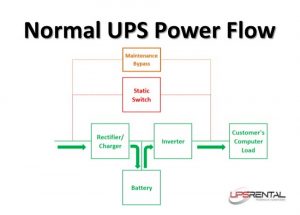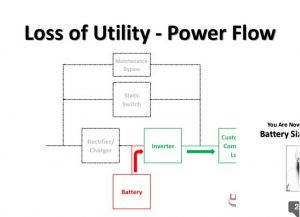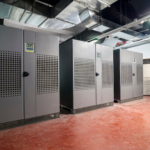In this edition of the Battery Blog’s Learning Center, Gene McNeil, Vice President of Critical Power Systems at Sure Power highlights the inner workings of a simple, double-conversion UPS system. In this video you will learn how the power flow changes in the event of a power outage. Gene also reviews the rules for properly sizing batteries for a UPS system.
This is a very simple basic block diagram of a UPS. The utility power enters at the Rectifier/Charger. When I say utility power, I’m referring to the local power company that supplies your building with power – for instance PECO Energy. They supply the power coming into building – where you would plug in your computer. That power would then come into the UPS. This whole thing is the UPS, everything from red down is inside the UPS box itself. The power comes in and goes to a Rectifier/Charger, and basically takes the A/C power and converts it into D/C (something that the batteries can use). We are constantly charging the batteries. We take the D/C voltage and convert it back to A/C through an inverter. In the event that there is an issue with the UPS and it has a failure, it has a built in Static Switch. It will transfer from UPS right over to Utility Power. In the event you have to do maintenance, there is another switch outside of the UPS then you can actually close this switch and pull the entire UPS out and replace it if you had to.
This is the power flow for a UPS system. The power comes in from the wall, through the charger, continues to charge the batteries, from the batteries to the inverter, the inverter converts if from D/C back to A/C and then out to the computer load.
In the event that there is a power outage, what happens is all these gray boxes are de-energized. So you have no power going to your rectifier/charger, no power going to the static switch and you have no power going to the maintenance bypass. The only power you have is from the battery system. So the battery basically feeds the inverter, the inverter makes A/C power and pumps it out to the computer load.
With our ever increasing use of “connected devices” (PC’s, cell phones, tablets, etc.), we expect dependable power. One second of power loss can cause loss of business and expensive equipment damage. Because of this, UPS systems are becoming more popular. Whether a small residential user or a large corporate data center, the basic technology for UPS systems remains the same. It is typically the scale or power rating that differs.
When you need protected, reliable power Sure Power delivers. We can support your facility move, system upgrade, maintenance window, or existing system failure. We are the nation’s largest rental UPS supplier. With rental UPS systems from 15kVA up to 1.5MVA, we typically ship our systems within two hours of receiving your order. Contact Sure Power for your rental UPS needs today.
Access to the slide deck are available on slideshare below.








